Patrick Roefflaer
This article is part of a series of over 30 articles which review the artwork on each of Dylan’s albums. Today it is John Wesley Harding.
You can find an index to all the previous articles in this series here
- Album: John Welsley Harding
- Released: December 27, 1967
- Photographer: John Berg
- Liner Notes: Bob Dylan
- Art-director: John Berg
1967 was the year of Sgt. Pepper’s Lonely Hearts Club Band, psychedelic music, the Summer of Love… Pretty “colors ev’rywhere”, as The Rolling Stones put it in ‘She’s a Rainbow’.
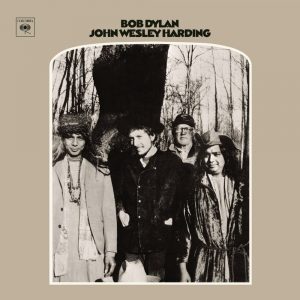 What a sharp contrast with Bob Dylan’s new album released in the last week of the year. John Wesley Harding, the first new material of the singer in more than 18 months, appears without any publicity. No sitars on this album, no screeching guitar solos, just twelve short acoustic songs with pared-down lyrics.
What a sharp contrast with Bob Dylan’s new album released in the last week of the year. John Wesley Harding, the first new material of the singer in more than 18 months, appears without any publicity. No sitars on this album, no screeching guitar solos, just twelve short acoustic songs with pared-down lyrics.
The monochrome cover too seems simple and down to earth: surrounded by a grey border, you see an informal black and white photo, like a snapshot from a family album.
At first glance there are four unknown men with hats. For most people at the time it must have taken a while to recognize the man in the middle as Bob Dylan. He looks very different to the young man from the ’66 World Tour: gone is the big curly hairdo, gone are the dark glasses…. They are replaced by a black cowboy hat and a fluffy beard. And then there’s that grin… He looks older, grown up…
The austere photo is taken by Columbia Records art director John Berg himself. “[Dylan’s manager] Albert Grossman called me and said Bob wanted to be able to see the pictures right away to make a decision, so I suggested we use Polaroids.” For his trip, all the way to Woodstock, Berg is accompanied by his boss, Bob Cato. Cato carries a color camera and Berg a black and white one.
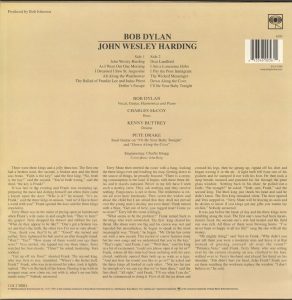 The photo session takes place in the garden of the house of Dylan’s manager, Albert Grossman. “It was the coldest day of the year’, recalled Berg. ‘It was like 20 below zero. It was so cold that we ran outside, the Bauls, the woodworker and whoever else were there, took pictures until it was no longer possible and then rushed back in for a brandy. As soon as I took a picture, someone tucked the Polaroid under his arm, as they should not get too cold during development. Inside, we placed the photos on a fancy large table and Bobby chose this photo for the cover.”
The photo session takes place in the garden of the house of Dylan’s manager, Albert Grossman. “It was the coldest day of the year’, recalled Berg. ‘It was like 20 below zero. It was so cold that we ran outside, the Bauls, the woodworker and whoever else were there, took pictures until it was no longer possible and then rushed back in for a brandy. As soon as I took a picture, someone tucked the Polaroid under his arm, as they should not get too cold during development. Inside, we placed the photos on a fancy large table and Bobby chose this photo for the cover.”
It all sounds very simple.
But is it really that simple? And who are those other guys?
The Bauls of Bengal
Who are these people Berg called Bauls and how do they end up with Bob Dylan?
They are identified as Purna (actually Purnan) and Luxman Das, sons of Nabani Das Khyepa Baul, the last real ancient adept avadhuta tantric bauls of Bengal.
Bengal, a region in the northeast of India, has had a tradition of itinerant musicians going back centuries, called bauls. Bauls were Sanskrit scholars in the oral tradition. In their mostly self-written songs, these men convey a message of “eternal truth.” “Baul” means something akin to “half way” implying that they don’t care much about social norms. It is a nickname that the musicians wear with pride.
When in the mid-1960s, influenced by John Coltrane and The Beatles, interest in Indian music arouse, the poet Allen Ginsberg advised Grossman to contact the Bauls. Ginsberg had moved to India in 1962 and stayed for some time with Nabani Das.
Grossman contacted him, but as bauls had never left India before, Nabani Das wouldn’t travel to the USA. However he advised his sons to take up the invitation.
In an interview published in 1995 in The Telegraph India, Purna Das shared how he ended up in Woodstock. “It started with a phone call. It was [January] 1967 and I was living in Kali Temple Road. The Oberoi Grand Hotel boss told me that Albert Grossman, Bob Dylan’s manager, wanted to meet me. […] He invited me to America. I said yes and said I would bring ten to twelve people. That was fine for him.”
Their first performance took place on September 14, 1967, at the legendary Fillmore in San Francisco. They were on the bill as LDM Spiritual Band, with LDM standing for Lok Dharma Mahashram. That was an idea from Asoke Fakir, a journalist who – the only one in the company – spoke English and therefore set himself up as their manager. Asoke also happened to be the founder and “International Chairman” of the Mahashram of the same name.
But when Asoke suddenly disappeared, taking all the money with him, Grossman provided shelter for the stranded musicians in a newly furnished apartment above a barn in the grounds around his home. “Albert took [us] to Woodstock,” confirms Purna, “It was there that I first met Bob Dylan, as well as artists like Joan Baez, members of The Band, Tina Turner, Peter, Paul …”
Dylan showed interest in the company. He liked to experiment with their strange instruments and listened to their philosophy that wisdom is obtained by getting to know your own body. “One night he told me that if I am a Bengali Baul from India, he was an American Baul,” Purna Das recalls. “We both bring music with roots. Our goals are the same, he said: “Sing to the people, tell their translations and spread love through music”. ” Purna believes that Dylan asked de Bauls to pose for the photo in order to make them more famous.
Sgt. Pepper’s Lonely Hearts Club Band
Some fans see the artwork of John Wesley Harding as an answer/parody to that of The Beatles’ Sgt. Pepper. Although there’s no sign of him playing any of that albums’ song during the months he spent playing with the Band in the basement of their Big Pink house, Dylan must have been aware of that album as his portrait can be seen on the cover. Like everybody else in that picture he was contacted to give permission to use it.
On the cover photo, The Beatles are surrounded by a multitude of famous figures: movie stars, writers, singers, philosophers and Eastern gurus.
Like The Beatles, Dylan takes center stage in his photo, but instead of a mass of familiar cardboard heads, his company consists of only three men. Two of them can be seen as his Eastern gurus.
Sally Grossman however didn’t buy that theory. In 2002, she declared, “The Bauls lived there [in Woodstock] and so did Dylan. Their attendance was not planned. The fact that the local carpenter is also in the picture proves that it is all pure coincidence.”
That carpenter and stonemason is identified as Charlie Joy, who happened to be working at Grossman’s house that day.
The fifth man
Now there’s only the white hat, front left that remains a mystery.
From one of two other photos known from this session, we know that a fifth person was indeed present. It is not known who he is and especially why only his hat can be seen in the photo. Is the man squatting? Or is his hat left on a stump?
More Beatles?
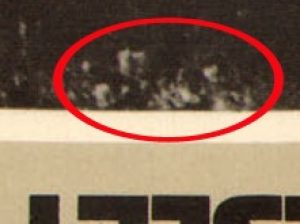 Music fragments played in reverse and psychedelic effects on the covers from that time stimulate – perhaps sharpened by mind-altering means – to search for hidden messages. People have even been caught making a hole in a cover to be able to play it on their turntable. The most striking example is the ridiculous but persistent “Paul is dead” story.
Music fragments played in reverse and psychedelic effects on the covers from that time stimulate – perhaps sharpened by mind-altering means – to search for hidden messages. People have even been caught making a hole in a cover to be able to play it on their turntable. The most striking example is the ridiculous but persistent “Paul is dead” story.
Dylan’s seemingly simple cover does not escape the sleuths either. On March 9, 1968, the American magazine Rolling Stone published an article entitled “Dylan Record Puts Beatles Up a Tree.” It explains that faces would be hidden just about everywhere in the cover photo of John Wesley Harding. “Most obvious is a group of faces that become visible when you turn the cover upside down; in the treetop, in the lighter part, you can see at least seven faces. Turning the cover in other directions reveals even more faces: near elbows, bushes and the lines of the coats. ”
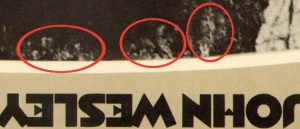 If you really want to, you can spot John Lennon and / or George Harrison as the most visible figures.
If you really want to, you can spot John Lennon and / or George Harrison as the most visible figures.
That leads to speculation that the faces would be those of the four Beatles, plus some of their friends. Donovan maybe?
The author of the article, Michael Ochs, contacted the photographer about it.
“It’s quintessentially Dylan,” replied John Berg vaguely, “Very mystical.”
He didn’t want to go into it further. “Happy Hunting,” he added.
In the 1990s, John Bauldie wrote a series about Bob Dylan’s covers. For this he asked Berg again about the hidden images. “I got a call from Rolling Stone in San Francisco,” he explained. “Someone had discovered little Beatles faces and Jesus’ hand in the trunk. Well, I had a proof of the cover on the wall. So I took it off and turned it around and yes… Hahaha! I mean, if you wanted to see it, you saw it. I was just as amazed as anyone else.”
No longer monochrome
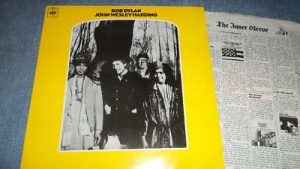 In England and the rest of Europe the record was released weeks later than in the US: at the end of January or even in February 1968. Curiously enough, the gray border around the photo has been adjusted for these pressings: a kind of pale beige in England and a bit sepia-ish for the mainland. In the eighties more color variants followed with a kind of fluorescent yellow as a bizarre low point.
In England and the rest of Europe the record was released weeks later than in the US: at the end of January or even in February 1968. Curiously enough, the gray border around the photo has been adjusted for these pressings: a kind of pale beige in England and a bit sepia-ish for the mainland. In the eighties more color variants followed with a kind of fluorescent yellow as a bizarre low point.
Do you have a tale to tell via Untold Dylan?
We now have over 2000 articles on this site, and many of them are personal tales about attending a concert, listening to Dylan, cover versions, or the individual writer’s own appreciation of Dylan and his music.
These articles are written for Untold by Dylan fans, and if you have a view of Dylan that you feel could be of interest to others, we’d love to hear from you.
To see the variety of approaches we have included in this site, just go to the top of the page and look at the various headings under the picture – each one contains an index of articles on a Dylan theme. Or look at the latest series listed on our home page. If you write a piece you can add to these, or create your own theme, or simply send in a one-off contribution. As long as it gives a different insight into Dylan and his work, we may be well interested in publishing it.
Sadly, we don’t have the funds to pay, but Untold Dylan does have a very wide readership, so your work will be seen by a huge number of people. If you have an article please email Tony@schools.co.uk If the article is ready, please attach as a word file.
One other thing: we never ask for donations, and we try to survive on the income from our advertisers, so if you enjoy Untold Dylan, and you’ve got an ad blocker, could I beg you to turn it off while here. I’m not asking you to click on ads for the sake of it, but at least allow us to add one more to the number of people who see the full page including the adverts. Thanks.
And one other, other thing: we also have a very lively discussion group “Untold Dylan” on Facebook with around 8500 active members. Just type the phrase “Untold Dylan” in, on your Facebook page or follow this link And because we don’t do political debates on our Facebook group there is a separate group for debating Bob Dylan’s politics – Icicles Hanging Down

I see George, Ringo, and John; but no Paul, as we all know, at this time, that Paul was dead.
I went to Sam Goody in Manhattan to get the album, on the day it came out. I was 13 years old. A clerk in the store told me about the hidden faces in the tree, and said “You’ll be the first kid in your neighborhood to know about that”
JOHN WESLEY HARDING was released in the UK on Friday, 23 February 1968.
Can Anthony Kane please tell us the date on which he bought JOHN WESLEY HARDING at a Sam Goody shop in Manhattan?
And, if he can’t (understandably) recall the exact date, please tell us how he knows it was the day the album was released.
And, if he still has that copy, whether it is a mono or stereo copy?
As I recall, the Bauls played at more than one venue in or around San Francisco at that time and I’m not sure that the Fillmore was their first. I say this tentatively, having once come across newspaper ads for concerts that included them on the bill. Unfortunately, I can’t remember the details and I can’t locate those ads now. Therefore, I’m not sure if I ever filed them or simply read them – but that’s what’s in my mind.
An article in the latest ISIS covers four musical events that Dylan attended (or may have attended) in 1967. One of these came from a mid-June 1967 newspaper report saying that he had been in San Francisco for the last week. This snippet was tagged as one of the “sure facts”. The other was that a local Columbia Records rep had confirmed that Dylan had re-signed with the company – not something announced at the point in time, which tends to lend the report credence. However, there was one rather surprising rumour.
This was that Dylan had attended the Moby Grape promotion party on the 7 June 1967. This event was, to say the least, an extravagant affair even for the time and part of an extensive national campaign. The latest ISIS gives more details but the whole thing was way over the top and, I suspect, a significant factor in Dylan choosing an album cover much duller than others at that time – as well the other restrictions he placed on the release of the album.
There is a bit more to say but, perhaps, kept for a future article. Meanwhile, you may care to check ISIS # 229.
Wrong! The album was released in England the day after Boxing Day 1967 – that is, December 27. I remember, with absolute certainty, visiting the record store and asking for it to be played in one of the listening booths they had in those days. And I remember my shock when I heard it. My first reaction to the opening notes – they’re playing the wrong record, this isn’t Dylan. And when I saw the actual cover, it confirmed my doubts – who was this mystery guy? Had the motorcycle accident 18 months earlier brought about a totally transfigured Dylan? A landmark album, one of his greatest.
Just before the release date debate goes any further, I think it is fairly true to say that the release date varies from country to country. December 25 and 26 are holidays in England and Wales, but I think at the time was not a public holiday in Scotland. That may have changed since. But I will always congratulate anyone who has clear memories of 1967. Mine, sadly are not quite so clear
@twm Sorry, just now saw your comment. All I can recall is that Sam Goody’s had just received it that day. I got a Mono copy, (still have it), and remember that it had a plastic sleeve. Cheers!